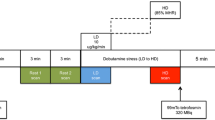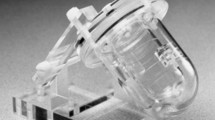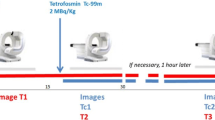Abstract
Purpose
The aim of this study was to assess the ability of real-time breath-hold-triggered myocardial perfusion imaging (MPI) using a novel cadmium-zinc-telluride (CZT) gamma camera to discriminate artefacts from true perfusion defects.
Methods
A group of 40 patients underwent a 1-day 99mTc-tetrofosmin pharmacological stress/rest imaging protocol on a conventional dual detector SPECT gamma camera with and without attenuation correction (AC), immediately followed by scanning on an ultrafast CZT camera with and without real-time breath-hold triggering (instead of AC) by intermittent scanning confined to breath-hold at deep inspiration (using list mode acquisition). We studied the use of breath-hold triggering on the CZT camera and its ability to discriminate artefacts from true perfusion defects using AC SPECT MPI as the reference standard. Myocardial tracer uptake (percent of maximum) from CZT was compared to AC SPECT MPI by intraclass correlation and by calculating Bland-Altman limits of agreement.
Results
AC of SPECT MPI identified 19 apparent perfusion defects as artefacts. Of these, 13 were correctly identified and 4 were partially unmasked (decrease in extent and/or severity) by breath-hold triggering of the CZT scan. All perfusion defects verified by SPECT MPI with AC were appropriately documented by CZT with and without breath-hold triggering. This was supported by the quantitative analysis, as the correlation (r) of myocardial tracer uptake between CZT and AC SPECT improved significantly from 0.81 to 0.90 (p<0.001) when applying breath-hold triggering. Similarly, Bland-Altman limits of agreement were narrower for CZT scans with breath-hold triggering.
Conclusion
This novel CZT camera allows real-time breath-hold triggering as a potential alternative to AC to assist in the discrimination of artefacts from true perfusion defects.


Similar content being viewed by others
References
Thomas GS, Miyamoto MI, Morello AP 3rd, Majmundar H, Thomas JJ, Sampson CH, et al. Technetium 99m sestamibi myocardial perfusion imaging predicts clinical outcome in the community outpatient setting. The Nuclear Utility in the Community (NUC) Study. J Am Coll Cardiol 2004;43:213–23.
Burrell S, MacDonald A. Artifacts and pitfalls in myocardial perfusion imaging. J Nucl Med Technol 2006;34:193–211.
Segall GM, Davis MJ. Prone versus supine thallium myocardial SPECT: a method to decrease artifactual inferior wall defects. J Nucl Med 1989;30:548–55.
Fleischmann S, Koepfli P, Namdar M, Wyss CA, Jenni R, Kaufmann PA. Gated (99m)Tc-tetrofosmin SPECT for discriminating infarct from artifact in fixed myocardial perfusion defects. J Nucl Med 2004;45:754–9.
Bailey DL, Hutton BF, Walker PJ. Improved SPECT using simultaneous emission and transmission tomography. J Nucl Med 1987;28:844–51.
Schepis T, Gaemperli O, Koepfli P, Ruegg C, Burger C, Leschka S, et al. Use of coronary calcium score scans from stand-alone multislice computed tomography for attenuation correction of myocardial perfusion SPECT. Eur J Nucl Med Mol Imaging 2007;34:11–9.
Cho K, Kumiata S, Okada S, Kumazaki T. Development of respiratory gated myocardial SPECT system. J Nucl Cardiol 1999;6:20–8..
Segars WP, Tsui BMW. Study of the efficacy of respiratory gating in myocardial SPECT using the new 4-D NCAT. IEEE Trans Nucl Sci 2000;47:1192–5.
Livieratos L, Rajappan K, Stegger L, Schafers K, Bailey DL, Camici PG. Respiratory gating of cardiac PET data in list-mode acquisition. Eur J Nucl Med Mol Imaging 2006;33:584–8.
Kovalski G, Israel O, Keidar Z, Frenkel A, Sachs J, Azhari H. Correction of heart motion due to respiration in clinical myocardial perfusion SPECT scans using respiratory gating. J Nucl Med 2007;48:630–6.
Martinez-Moller A, Zikic D, Botnar RM, Bundschuh RA, Howe W, Ziegler SI, et al. Dual cardiac-respiratory gated PET: implementation and results from a feasibility study. Eur J Nucl Med Mol Imaging 2007;34:1447–54.
Herzog BA, Buechel RR, Katz R, Brueckner M, Husmann L, Burger IA, et al. Nuclear myocardial perfusion imaging with a cadmium-zinc-telluride detector technique: optimized protocol for scan time reduction. J Nucl Med 2010;51:46–51.
Buechel RR, Herzog BA, Husmann L, Burger IA, Pazhenkottil AP, Treyer V, et al. Ultrafast nuclear myocardial perfusion imaging on a new gamma camera with semiconductor detector technique: first clinical validation. Eur J Nucl Med Mol Imaging 2010;37:773–8.
Hesse B, Tagil K, Cuocolo A, Anagnostopoulos C, Bardies M, Bax J, et al. EANM/ESC procedural guidelines for myocardial perfusion imaging in nuclear cardiology. Eur J Nucl Med Mol Imaging 2005;32:855–97.
Kovalski G, Keidar Z, Frenkel A, Israel O, Azhari H. Correction for respiration artefacts in myocardial perfusion SPECT is more effective when reconstructions supporting collimator detector response compensation are applied. J Nucl Cardiol 2009;16:949–55.
Pitman AG, Kalff V, Van Every B, Risa B, Barnden LR, Kelly MJ. Contributions of subdiaphragmatic activity, attenuation, and diaphragmatic motion to inferior wall artifact in attenuation-corrected Tc-99m myocardial perfusion SPECT. J Nucl Cardiol 2005;12:401–9.
Hesse B, Lindhardt TB, Acampa W, Anagnostopoulos C, Ballinger J, Bax JJ, et al. EANM/ESC guidelines for radionuclide imaging of cardiac function. Eur J Nucl Med Mol Imaging 2008;35:851–85.
Masood Y, Liu YH, Depuey G, Taillefer R, Araujo LI, Allen S, et al. Clinical validation of SPECT attenuation correction using x-ray computed tomography-derived attenuation maps: multicenter clinical trial with angiographic correlation. J Nucl Cardiol 2005;12:676–86.
Acknowledgments
This study was supported by a grant from the Swiss National Science Foundation and by the ZIHP (Zurich Center for Integrative Human Physiology, University of Zurich, Switzerland). We would like to thank Edlira Loga and Ennio Mueller for their excellent technical support.
Disclosure
The University Hospital Zurich holds a research grant with GE Healthcare.
Author information
Authors and Affiliations
Corresponding author
Additional information
Ronny R. Buechel and Aju P. Pazhenkottil contributed equally to this work.
Rights and permissions
About this article
Cite this article
Buechel, R.R., Pazhenkottil, A.P., Herzog, B.A. et al. Real-time breath-hold triggering of myocardial perfusion imaging with a novel cadmium-zinc-telluride detector gamma camera. Eur J Nucl Med Mol Imaging 37, 1903–1908 (2010). https://doi.org/10.1007/s00259-010-1480-7
Received:
Accepted:
Published:
Issue Date:
DOI: https://doi.org/10.1007/s00259-010-1480-7




